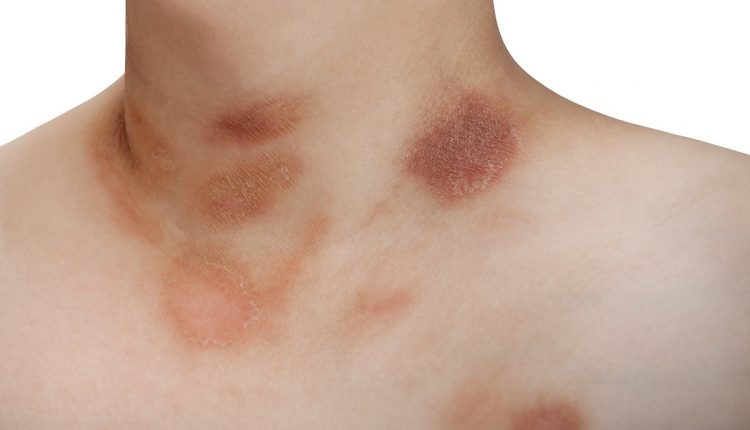
Pityriasis Rosea (Gibert's): ຄໍານິຍາມ, ສາເຫດ, ອາການ, ການບົ່ງມະຕິແລະການປິ່ນປົວ
Pityriasis rosea of Gibert ເປັນພະຍາດຜິວໜັງທີ່ອ່ອນເພຍ, ມີອາການສ້ວຍແຫຼມ, ສ່ວນຫຼາຍມັກຢູ່ໃນເດັກນ້ອຍຫຼືຜູ້ໃຫຍ່ອາຍຸ 10 ຫາ 35 ປີ.
It is characterized by the sudden appearance of a main reddish and scaly patch, oval in shape called “mother patch” or “Medallion of Gibert”, followed after a few days by the appearance of other similar although smaller spots.
The term “pityriasis” has Greek origins: literally, the meaning refers to “bran”, a metaphor that originates from the typical flaking of the mother spot.
It heals spontaneously within 40-60 days of its onset without any treatment, but it cannot be prevented and sometimes it can even recur even after many years but in a mild form.
Generally the disease does not cause discomfort except itching in rare cases, so the only forms of treatment provided are aimed at relieving this symptom.
Pityriasis rosea (Gibert’s) mainly affects young people between the ages of 10 and 35
In infants and toddlers it tends to present in a more aggressive form and to be associated with urticaria.
The probability of the onset of pityriasis rosea in pregnant women is slightly higher than in other women; since some symptoms are common to syphilis, it is necessary to carry out specific tests to exclude it
Although the reason is not yet known, the onset of this disease occurs mostly in the spring and autumn months.
ສາເຫດ
The etiology is currently unknown.
Pityriasis rosea is believed to arise as a result of a viral infection, specifically caused by herpes virus strains (strain 6 and 7, responsible for sixth disease in childhood).
Prolonged exposure to some chemical agents or dusts, responsible for greater dryness of the skin, could also play a significant role.
However, the disease is not considered contagious (very few cases have been identified in the same household) and it is therefore possible to lead a normal life without self-isolation.
ອາການແລະອາການຕ່າງໆ
Pityriasis rosea manifests itself with the appearance on the trunk of a single reddish and scaly spot, slightly raised, called the “mother spot”, which can extend up to 10 cm in diameter.
Generally there are no prodromal symptoms, but if present the most common are nonspecific complaints such as headache, fatigue, fever and joint pain.
A few days to 2 weeks after the mother patch appears, a widespread rash develops in the patient and may continue to spread over the next 2 to 6 weeks.
The spots that appear are smaller and scaly (0.5 – 1.5 cm in diameter) and are arranged in a symmetrical radial pattern usually on the chest, back, belly, ຄໍ, scalp and upper limbs.
The face is usually unaffected.
Children also more commonly have an inverse form of pityriasis rosea, i.e. lesions located on the armpits and groin with centrifugal diffusion
Except in some cases where it can be itchy (especially in children suffering from atopic dermatitis), the disease generally does not cause particularly serious problems
In dark-skinned people, hypochromic (white or light patches) or hyperchromic (dark patches) spots may appear after resolution, but in most cases this is temporary.
ການວິນິໄສ
For the diagnosis, a simple physical examination is often sufficient for the dermatologist.
In doubtful cases, i.e. in which it is necessary to make a differential diagnosis with other similar conditions (cutaneous mycoses, viral exanthemas, guttate psoriasis, Lyme disease, drug rashes, pityriasis versicolor, etc.) further investigations may be necessary.
Among these, serological tests (to rule out syphilis in cases where the lesions affect the palms of the hands and soles of the feet), microscopic tests (to rule out mycosis), or histological tests, although skin biopsy is rarely performed.
There are some atypical forms of pityriasis rosea that make its diagnosis complex
ລະຫວ່າງເຫຼົ່ານີ້:
- Giant pityriasis rosea: form of dermatosis affecting the scalp, genitals, oral mucosa and nails.
- Inverted or inverse pityriasis rosea: typical of people with dark olive-skinned skin with macules that spread to unusual anatomical areas such as the legs, arms and face.
- Pityriasis Rosea circinata and Vidal marginata: the spots are larger in size and this form can last for months.
- Vesicular pityriasis rosea: more frequent among black-skinned subjects.
- Pityriasis Rosea urticata: form of pityriasis also accompanied by urticaria.
ການແຊກແຊງແລະການປິ່ນປົວ
No specific treatment is needed for Gibert’s pityriasis rosea, as symptoms usually resolve on their own within 5 weeks and recurrences are rare.
Exposure to sunlight seems to speed healing, but if the skin is particularly sensitive it is better to avoid it.
Some studies suggest that acyclovir may be useful in patients with early-onset, widespread disease or flu-like symptoms, in order to reduce its duration or severity.
In cases of intense itching, the use of oral antihistamine drugs or the topical application of cortisone-based ointments is recommended, while the systemic administration of cortisone is not recommended.
Especially in children, or in adults with excessive scaling, it may be useful to apply talcum powders or menthol-based emollient creams.
ອ່ານຍັງໄດ້
ມີຊີວິດສຸກເສີນຫຼາຍຂຶ້ນ…ສົດ: ດາວໂຫລດແອັບຟຣີໃໝ່ຂອງໜັງສືພິມຂອງເຈົ້າສຳລັບ IOS ແລະ Android
Nevi: ສິ່ງທີ່ພວກເຂົາເປັນແລະວິທີການຮັບຮູ້ Melanocytic Moles
ການກວດຜິວໜັງເພື່ອກວດຫາຈຸດດ່າງດຳ: ເມື່ອໃດທີ່ຕ້ອງເຮັດ
ເນື້ອງອກແມ່ນຫຍັງແລະມັນເກີດຂື້ນໄດ້ແນວໃດ
ພະຍາດທີ່ຫາຍາກ: ຄວາມຫວັງໃFor່ສໍາລັບພະຍາດ Erdheim-Chester
ວິທີການຮັບຮູ້ແລະປິ່ນປົວ Melanoma
Moles: ຮູ້ຈັກພວກມັນເພື່ອຮັບຮູ້ Melanoma
Melanoma ຜິວຫນັງ: ປະເພດ, ອາການ, ການບົ່ງມະຕິແລະການປິ່ນປົວຫລ້າສຸດ
Melanoma: ການປ້ອງກັນ ແລະການກວດຜິວໜັງແມ່ນມີຄວາມຈຳເປັນຕໍ່ກັບມະເຮັງຜິວໜັງ
Dysplastic Nevus ແມ່ນຫຍັງ ແລະມີລັກສະນະແນວໃດ?
ເຊື້ອເຫັດເລັບ: ພວກມັນແມ່ນຫຍັງ?
Onychophagia: ລູກຂອງຂ້ອຍກັດເລັບຂອງລາວ, ເຮັດແນວໃດ?
ຣັດເຊຍ, ທ່ານ ໝໍ ກວດພົບໂຣກ mucormycosis ໃນຄົນເຈັບ Covid-19: ສາເຫດຂອງການຕິດເຊື້ອຂອງເຊື້ອເຫັດແມ່ນຫຍັງ?
Parasitology, Schistosomiasis ແມ່ນຫຍັງ?
Onychomycosis: ເປັນຫຍັງເລັບມືແລະເລັບຕີນໄດ້ຮັບເຊື້ອເຫັດ?
Nail Melanoma: ການປ້ອງກັນແລະການບົ່ງມະຕິເບື້ອງຕົ້ນ
ເລັບ Ingrown: ວິທີແກ້ໄຂແມ່ນຫຍັງ?
ແມ່ທ້ອງແລະແມ່ທ້ອງໃນອາຈົມ: ອາການແລະວິທີການກໍາຈັດພວກມັນດ້ວຍຢາແລະວິທີແກ້ໄຂທໍາມະຊາດ
ພະຍາດ 'ມື ແລະ ປາກ' ແມ່ນຫຍັງ ແລະວິທີການຮັບຮູ້ມັນ
Dracunculiasis: ການສົ່ງຕໍ່, ການບົ່ງມະຕິແລະການປິ່ນປົວຂອງ 'ພະຍາດ Guinea-ແມ່ທ້ອງ'
Parasitoses ແລະ Zoonoses: Echinococcosis ແລະ Cystic Hydatidosis
Trichinosis: ມັນແມ່ນຫຍັງ, ອາການ, ການປິ່ນປົວແລະວິທີການປ້ອງກັນການຕິດເຊື້ອ Trichinella
Dermatomycosis: ພາບລວມຂອງ Mycoses ຜິວຫນັງ
Dysplastic Nevus: ຄໍານິຍາມແລະການປິ່ນປົວ. ພວກເຮົາຄວນເປັນຫ່ວງບໍ?



